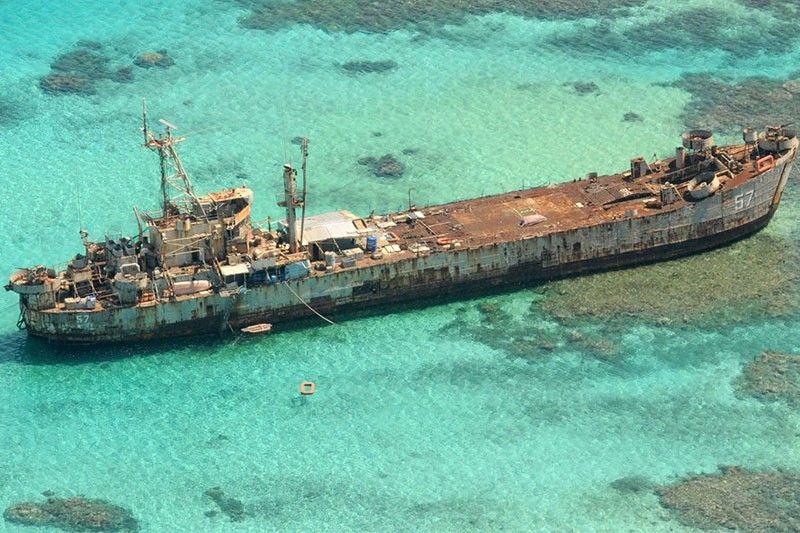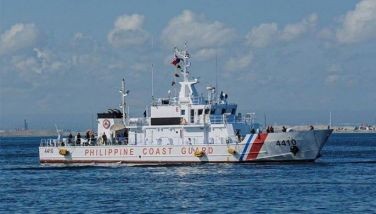Philippines-China deal: Clashing claims amid 'fragile truce' over Ayungin

MANILA, Philippines — Disgruntled over China's immediate "mischaracterization" of the deal it struck over Ayungin Shoal, Philippine officials now appear to be on a wait-and-see approach on whether their provisional arrangement with Beijing is enough to keep tensions from again flaring up.
Exactly what the Philippines and China agreed upon has yet to be spelled out to the public. Both the Philippines and China decided not to disclose the text yet to "give it a chance to work first," said National Security Council Assistant Director General Jonathan Malaya in a One News interview on July 23.
"And later, when we see the sincerity of both sides, then we will be able to release those details," Malaya said.
But for retired Supreme Court justice Antonio Carpio, what was clear was that there was "no meeting of the minds" as the Philippines refuted China's messaging about the deal just hours after its announcement.
Clashing assertions
The Philippines on July 21 announced that it had “reached an understanding on the provisional arrangement” with China to de-escalate tensions during its resupply missions to decommissioned navy vessel BRP Sierra Madre aground on Ayungin Shoal after months of aggressive altercations came to a head in June.
RELATED: Filipino sailor’s thumb loss an 'accident' from boat collision — PCG
The Department of Foreign Affairs (DFA) said the two parties reached an agreement to "[avoid] misunderstandings and miscalculations, without prejudice to national positions.”
First instance. Less than a day after the DFA announced the agreement, China, through a spokesperson, issued a statement alleging the Philippines would "inform China in advance" prior to its resupply missions. China's statement also implied the Philippines would eventually "[tow] away" the warship.
The Philippines' response came within hours. "I want to stress that the agreement was concluded with the clear understanding by both sides that it will not prejudice our respective national positions," said DFA spokesperson Teresita Daza on the morning of July 22.
Malaya said he was "shocked" to read China's statement as it was Chinese officials who asked for a sit-down talk.
But the actual test of the durability of the deal came a week later during Philippine forces' resupply mission.
Second instance. The Philippines and China again provided contrasting statements. For China, Filipino vessels had successfully completed its mission as "the entire process was monitored by China Coast Guard" and that "China had been notified of the resupply before it was carried out."
But the DFA refuted China's claims and immediately blasted their statement for "mischaracterizing" the deal. "It is not helpful to keep giving false notions about what has been agreed on and how they were implemented," Daza said.
A relief, not a game changer
How then, can the Philippines hold China to an agreement it does not see eye-to-eye?
In separate interviews with Philstar.com, geopolitical experts said the Philippines and China have issued contrasting statements about their deal precisely because the deal did not shift China's long-term strategy or ambitions in the South China Sea.
While the Philippines views the deal as a reaffirmation of its sovereignty, China frames it as a temporary measure to manage immediate tensions while continuing its broader claims over the contested waters, the experts said.
"China has had a very maximalist approach to its claims, so it's not surprising that they view things differently," said Ray Powell, Sealight director and defense and maritime expert. "What's really interesting is that the deal, at least for now, seems to be holding up anyway."
Dindo Manhit, president of think tank Stratbase ADR Institute, said there is enough basis to be "cautiously optimistic" about the potential for the agreement to bring Filipino fishers back to Ayungin Shoal.
"By securing a framework for resupply missions, the Philippines is not only reinforcing its sovereign rights but also creating a potential buffer against Chinese aggression," Manhit said.
Powell added that the agreement, despite the two parties' different messaging, shows a commitment by both countries to de-escalate tensions after multiple stand-off's in the past year. "They're uncomfortable, but satisfied with that as a status quo," he said.
China claims nearly all of the South China, including the West Philippine Sea, as theirs. Chinese vessels have recently resorted to using water cannons and other hostile tactics to foil the Philippines' supply missions to its troops stationed at BRP Sierra Madre.
"It's not a game changer. It is a relief. It relieves a very specific tension that didn't, didn't have an obvious solution to it," Powell said.
New flashpoint?
While the Senate has unanimously passed a resolution urging the DFA to raise China's incursions before the United Nations General Assembly, Powell said this would "certainly aggravate" China and threaten the two countries' already "fragile truce."
Even as several countries are on board with the 2016 arbitral ruling that invalidated China's sweeping claims in the South China Sea, with Beijing's influence in the UN, other nations who have no interest in the issue may be "bullied or convinced that their best recourse is to either vote against the Philippines or abstain," Powell added.
"If the Philippines lost that vote, that would really be disastrous," the geopolitical expert said.
And for Powell, the Philippines should be aware that China has not given up on the rest of its ambitions in the South China Sea and will likely "take the opportunity to apply pressure in a different area."
Continuing tensions. Filipino and Chinese vessels earlier this week came face-to-face on Sabina (Escoda) Shoal, a reef in the Spratly Islands that lies within the Philippines’ exclusive economic zone, after the Philippine Navy increased its monitoring and patrol amid the presence of the Chinese Coast Guard’s 12,000-ton “monster ship.”
The Philippine Navy also spotted a Chinese survey ship conducting “zigzag” and unauthorized patrols around 20 nautical miles away from Sabina Shoal on Tuesday.
These recent incidents demonstrate how “China's subsequent actions and its overall goal has not changed," Powell said.
"From the survey ship that's been moving around off the coast of Palawan to the standoff at Escoda Shoal, and they're still tightly controlling Scarborough Shoal," he added.
Asserting sovereignty. As scores of fishers keep being locked out of the West Philippine Sea due to Chinese vessels' presence, Carpio told Philstar.com that the Philippines must keep asserting its sovereign right in all its agreements with foreign powers.
“We can agree with China on anything except there are three ‘no’s … There must be no prior information or no prior notice, no prior consent and no on-site inspection,” the former high court magistrate said
“If we inform China, or we get the consent, or we allow onboard inspection, then we are saying that China has a claim, or China has a right over that same area. And if that's the case, we have no sovereign rights,” he added.
- Latest
- Trending
































